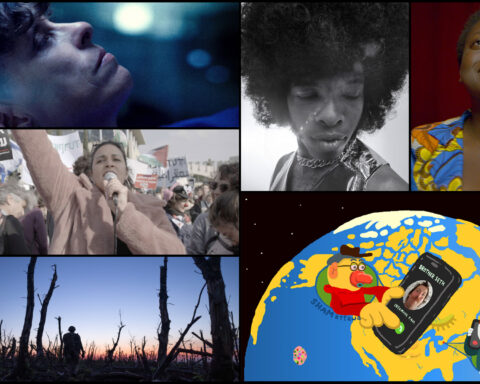Too often we hear about unprecedented, recordbreaking weather events—they’re happening with increasing regularity. At the close of last year’s Atlantic hurricane season, three brutal Category 4s (Harvey, Irma and Maria) made landfall, repeatedly pummelling Puerto Rico, the U.S. Virgin Islands, Louisiana and other parts of the Gulf Coast and the Caribbean. And yet that hyperactive storm season was not the only extreme weather of 2017; various parts of the world also experienced flooding, heat waves, drought, wildfires and, ultimately, the third warmest year on record. This era of disastrous weather is, of course, thanks to humaninduced climate change.
“The earth is rapidly moving into a less biologically diverse, less forested, much warmer and probably wetter and stormier state,” says Will Steffen, a professor at the Australian National University and member of the Working Group on the Anthropocene (WGA). The WGA, which consists of world renowned scientists, argues that these more frequent extreme weather events are characteristic of the new time we inhabit—the Anthropocene. WGA member and Nobel Prize-winning atmospheric chemist Paul Crutzen resurrected the term in 2002 in order to capture the central influence that civilization has on geology and ecology. According to Steffen, human activities “have become so pervasive and profound that they rival the great forces of Nature and are pushing the Earth into planetary terra incognita.”
The Anthropocene is a concept ripe for exploration by documentarians, who have a unique ability to depict the scale of human impact on the world. Notable among these are filmmakers Jennifer Baichwal and Nicholas de Pencier and photographer Edward Burtynsky, as exemplified by their film trilogy Manufactured Landscapes (2006), Watermark (2013) and Anthropocene (2018). Introduced in Manufactured Landscapes, and honed in Watermark, the filmmakers explore the magnitude of environmental destruction with seemingly endless footage of sprawling altered landscapes, expansive manufacturing processes and mountainous waste. Anthropocene is directly inspired by WGA research being submitted to the International Commission on Stratigraphy to recommend the use of “Anthropocene” instead of “Holocene” as the name for the current geological epoch. Anthropocene is divided into sections based on major categories of evidence examined by the WGA: terraforming, techno-fossils, anthroturbation, climate change, extinction and extraction.
Anthropocene is a stunning film, and not just in its depiction of the environmental damage. One section filmed in Italy mesmerizes with an extended pan outward to slowly reveal a marble quarry of almost incomprehensible size. The scene is uncomfortably beautiful. The stark white marble is shown being cut in symmetrical blocks from the side of a mountain; the blocks are so large in size that the industrial machinery used to carry them is destabilized, lifting onto its front wheels from the weight. Another section in Chile surprises with aerial shots of richly colourful evaporation ponds used to store and process lithium extracted from nearby mines. This lithium is revealed to be an integral chemical element found in our electronic products. As the shot of the ponds pans, a two-seater rowboat comes into view, reduced to a tiny speck on the horizon of countless other lithium lakes.
In Metamorphosis (2018), another examination of the Anthropocene, filmmakers Nova Ami and Velcrow Ripper (Occupy Love) poetically showcase the worry, fear, grief and hope of a changing climate at the hands of humans. Metamorphosis also utilizes at least one piece of evidence considered by the WGA: declining ocean health. The ocean’s most established coral reefs are upwards of 10,000 years old. About one quarter are considered damaged beyond repair and the other two thirds are under threat—and all within the last half-century, due to rising sea temperatures, overfishing and pollution. Ami and Ripper tell this story through environmentalist and artist Jason deCaires Taylor, who creates marine sculpture parks around the world which serve as emotional stories of loss and hope, as well as hosts for new coral and marine life. In its portrayal of hope, Metamorphosis also considers the story of the fragility and resiliency of the monarch butterfly, famed for its epic migrations between Canada and Mexico. The film asks viewers to examine the difficulty in facing changes that remind us of our own mortality, and of potential futurelessness. The ability to cope with change requires deep existential questioning, which is often avoided. Acknowledging the grief of climate change, and morphing this despair into praise of the things we love to protect, Metamorphosis suggests a way out of the self-created mire.
This mire is one that dates back to the 1800s, and the onset of industrialization, which Steffen believes is the point at which the current epoch began to assert itself. To facilitate a change in official geological time, indicators to track that time’s progression are needed. For example, the Cretaceous epoch was defined by sediments of the metal iridium, which was dispersed around the globe by the meteorite that collided with earth and ended the age of the dinosaurs. The Anthropocene, by contrast, is characterized by the fact that “humans and our societies have become a global geophysical force,” writes Steffen, and as such, there are plenty of indicators to choose from. One of those indicators could be the chemical composition of the atmosphere, which has changed due to elevated concentrations of carbon dioxide (CO²). CO² is measured in parts per million (ppm), which are then compared from the pre-industrial era (270-275 ppm) to current levels (400-410 ppm), in order to quantify their “significant consequences for Earth system functioning,” according to Steffen. WGA member and University of Leicester geology professor Jan Zalasiewicz points to radioactive elements left over from nuclear bomb tests as another potential indicator, which can be found in deposits that will make up future geological records. And yet, “we are spoiled for choice,” Zalasiewicz told The Guardian in a 2016 article. “There are so many signals.”
{The Holocene epoch began about 12,000 years ago, and is characterized by a warming climate and the rapid melting of global glaciers from the preceding epoch. In this ice retreat, “many of the surface bodies of sediment on which we live—the soils, rivers, deposits, deltas, coastal plains and so on—were formed,” says Zalasiewicz. As the earth’s temperatures and landscapes changed, so too did human hunting and gathering practices, giving way to the invention of agriculture (which would later change the planet so profoundly that the WGA considers it to be terraforming). During the Holocene, humans became settled members of communities, as well as producers of major civilizations with advanced forms of art, architecture, science and technology. It was during this epoch that humans subsequently developed complex industrial societies. The Industrial Revolution global mass production and consumption which contributed significantly to changes in the earth’s natural systems. In short: this planet is 4.5 billion years old, human civilization has been developing for 12,000 years, and in a tiny recent fraction of that time, the earth has experienced unprecedented, catastrophic harm.
Another piece of evidence being put forward by the WGA is the global mass endangerment and extinction of animal species, as represented in the films Sharkwater (2006), Revolution (2012) and Sharkwater Extinction (2018), by the late Rob Stewart. The impact of Sharkwater was palpable in its energizing awareness—the film inspired a generation of new conservation groups aimed at banning shark fishing and shark fin soup. However, Sharkwater Extinction creative consultant Sturla Gunnarsson notes that although Sharkwater had “given the sharks a little breathing room,” it was “then discovered that, in fact, sharks were disappearing at an increasing rate.” This shocking news sparked Stewart’s journey to learn why an increase of shark fishing was occurring despite the widespread ban.
Sharkwater Extinction is a behind-the-scenes, diaristic look at Stewart’s guerrilla approach to exposing the evils of the global shark fishing industry. Through the film’s various locations, from Costa Rica to California, viewers learn why and how this top oceanic predator, which is responsible for helping control the populations below, as well as oxygen-producing plankton, continue to be fished to critically low populations. Sharks have lived on earth well before the relatively short period of the Holocene, existing for over 400 million years and through five major global extinctions. And yet, in only 40 years, humans have decimated shark populations by upwards of 90 percent, killing off between 100 and 150 million sharks per year.
While many species of shark are in danger of going the way of the dinosaur in the Cretaceous epoch, others are rapidly spreading, due to human facilitation of invasive species. Rodents of Unusual Size (2017), by Chris Metzler & Jeff Springer (Plagues & Pleasures on the Salton Sea, 2006) and co-director Quinn Costello, helps make painfully clear the exacerbating effects that non-native species can have on existing threats such as terraforming and extreme weather. The comical and insightful film, with its repulsive and fascinating antagonist, is an emblematic tale of invasive species run amok. As this particular story goes, in the depression-era 1930s, the son of the creator of Tabasco hot sauce imported giant, webbed-footed, orange-toothed rodents named nutria to Louisiana in an effort to support the local fur trade. The “swamp rats” escaped, and with few natural predators their population swelled to 20 million. As their numbers boomed, so did the nutria’s damage to Louisiana’s ecologically fragile coastal wetlands; the semi-aquatic rodents burrowed through and consumed the vegetation which keeps wetlands intact. In Rodents of Unusual Size, the Louisiana Department of Wildlife and Fisheries notes that every mile of coastal wetland reduces storm and hurricane surge by about one foot. This is because wetlands act as a natural sponge, slowing down surges and impeding water from flowing on shore. So, in addition to development, drudging and gas exploration and extraction, non-native species can increase the vulnerability of areas that are already at risk of intensified weather events.
Another new film which considers the Anthropocene is Becoming Animal (2018) by Peter Mettler and Emma Davie. Its focus, however, is an examination of the human-centred thought which has contributed to the destructive treatment of the planet. Becoming Animal profiles the philosopher David Abram as he methodically narrates his ideas on going beyond human-first views of animals, encouraging viewers to reconsider relationships between humans and non-human animals and the rest of the natural world. Abram’s theatrical and whimsical, but nonetheless brilliant approach guides viewers to consider nature—not with the sense of the sublime which is done so well in Anthropocene and Metamorphosis, but with a deepened receptiveness. In Abram’s animism, “everything is alive, everything is expressive.” This concept is built into the filmmaking process itself, with Abram asking how filmmaking equipment can help us connect. The result is a trancelike film, replete with kaleidoscopic imagery and hypnotic sounds, that utilizes the technological lens through which we often view the world to put us onto the literal back of a soaring eagle, from which we can consider nature anew.
In the midst of the climate crisis, environmental documentary films like Anthropocene, Metamorphosis, Sharkwater Extinction, Rodents of Unusual Size and Becoming Animal are a necessary means of disseminating complex ideas such as the human-induced transition into an entirely new geological time period. By examining the concept of the Anthropocene, we are better able to comprehend not only the seemingly disparate issues discussed in these films, like the simultaneous extinction of sharks and expansion of rodents, but perhaps even more importantly, the source from which these issues originate—us.
Anthropocene: The Human Epoch is now playing in select theatres.
Sharkwater Extinction opens in theatres on Oct. 19.
Becoming Animal, Sharkwater Extinction, and Rodents of Unusual Size screen at Toronto’s Planet in Focus Environmental Film Festival.
Metamorphosis is coming soon to home video.
Becoming Animal (2018) Official Trailer from Peter Mettler on Vimeo.












